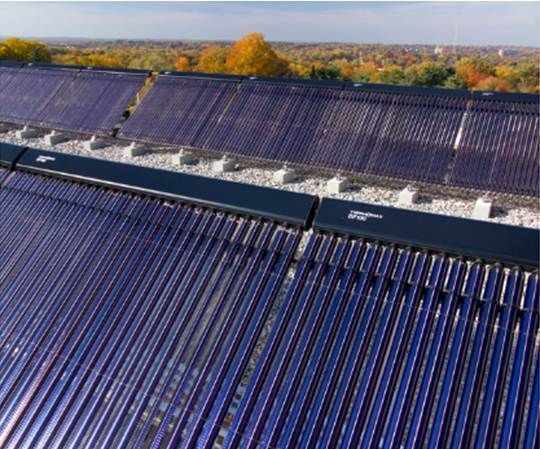Solar water heating (SWH) specialist Skyline Innovations just picked up a million dollars in venture capital, $30 million in backing from the investment arm of a natural gas utility, and added three multi-family buildings to its customer list. It's another sign that, in solar, third-party financing might in fact please all of the people all of the time.
Small-business-oriented VC firm Advantage Capital Partners’ million dollars will go to extending Skyline’s operational capabilities through software development, project management, and sales force hiring.
According to Skyline Innovations CEO Zach Axelrod, the $30 million investment from WGL Holdings, Inc., a natural gas utility and energy marketer/wholesaler, “should enable us to build 100 to 300 projects. Our average project is a mid-size commercial project worth from $100,000 to $300,000.”
Skyline just completed three such SWH system installations in Southern California. Building owner Williams Holdings had no upfront cost and will get solar hot water at a 25 percent fixed discount to its utility rate for water heating.
“We offer guaranteed savings on the hot water we provide,” Axelrod said. “We do that by measuring the BTUs we deliver and charging a fixed percentage discount to what a building owner or operator would have paid.”
“We work with multi-family buildings that are 50 units and up that have centralized hot water systems,” explained Skyline Marketing spokesperson Sandra Lee. “Our business model was engineered with the specific focus of taking the question of payback off the table for customers because we recognize that constraints on capital and fear of financial risk and uncertainty about payback are the major barriers to solar.”
Skyline exclusively uses third-party financing, today’s hottest concept in distributed solar. Using investors’ money, Lee said, “we fully finance and pay for, install, maintain and monitor the systems.” The only thing the customer pays for, she added, “is the hot water that gets delivered to their tap that they use that has originated from our system, not from the utility.”

Skyline was founded in 2009 and now has, Axelrod said, “about 45 systems. Our savings rates vary from 15 percent to 35 percent or 40 percent off what somebody would have paid for water heated by gas, electricity, propane or fuel oil.”
“A simple analogy we use,” added Lee, “is that if they pay a dollar per therm and they lock in a 30 percent savings rate, that means they pay 30 cents less per therm. They will always be better off with Skyline. They will always pay less for water heated by the sun than what they would pay their utility for water heated by any other conventional fuel.”
Third-party financing use has nearly tripled over the last year in the booming rooftop solar PV sector.
Though SWH technology is much older than PV, with patents as far back as the 1890s, the U.S. industry is growing much more slowly. And while the U.S. is among the world leaders in most renewable technologies, its SWH industry had only 2.3 gigawatts-thermal in 2010, while China had 118 gigawatts-thermal and the world had built about 185 gigawatts-thermal. The U.S. market is five times bigger than it was in 2005 and growing at 6 percent annually, according to recent SEPA statistics.
Third-party financing may be the boost SWH needs to gain a footing in the U.S. market. But industry veterans have expressed that the sector is urgently in need of standards -- both for equipment and installers.
Skyline’s success stems at least in part from the fact that it is widely recognized for using high-quality equipment and doing smart installations.
“Photovoltaic panels, in terms of output, are about 15 percent efficient. Solar thermal panels are somewhere between 40 percent and 70 percent efficient, depending on the collector type,” Axelrod said. But “the big difference between thermal and PV, in terms of efficiency, is that PV has a grid to push unused electricity back to.”
A SWH system has storage tanks, he explained. “If you size the solar hot water system appropriately, certainly you will collect more energy from solar hot water than from PV.”
Proper sizing, he said, “is a factor of the customer’s load profile matched against the size of the system in terms of both collectors and storage. Those three things all work together to determine your efficiency.”
The metric used in SWH for cost of capacity that compares to PV’s dollars per watt, Axelrod said, is dollars per square foot of collector. “For commercial, it is generally between $90 and $150 per square foot, which translates to, say, $3,600 to $6,000 per 40-square-foot collector. For residential, it’s a little higher.”
Skyline’s three new projects in Southern California, and its new Los Angeles office, mark a move there to take advantage of the opportunity offered by the California Solar Initiative Thermal Program’s $350 million allocation for the deployment of multi-family and commercial solar water heating systems.
Low natural gas prices, on the other hand, have hurt SWH. But, Axelrod noted, “they hurt everybody in the generation industry across the board. It hurts nuclear, wind, coal, natural gas power plants, and it hurts PV.” And, he added, “We are no different than anyone else. We often price against natural gas directly. But everyone in the generation business prices against natural gas either directly or indirectly. It hits us like it hits everyone.”




